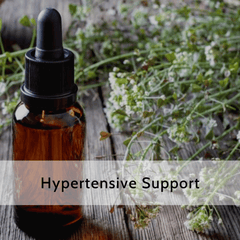Healthy Foods to Lower Your Blood Pressure
| Dana Woods
By Dana Woods, Herbalist, Wellness Coach, and Owner at Nature Gal Naturals
For those suffering from high blood pressure, health food is definitely your first line of defense.
You need to make sure you're staying hydrated, this helps keep blood pressure (BP) levels normal, while stabilizing magnesium levels. Are you adding magnesium to your diet?
Foods for High Blood Pressure
Healthy Foods: Basil, Ceylon cinnamon, Cardamom, Watermelon, Pistachio Nuts, Flax Seed, Garlic, Ginger, Hawthorn, Celery Seed, Beet Root, Pomegranate, French Lavender and Cat’s Claw.
A study, done in December of 2009, was published in the Indian Journal of Biochemistry & Biophysics. They gave a group of participants 1 teaspoon of cardamom powder daily for several weeks. The results showed a significant reduction in blood pressure. Combined with ginger and cinnamon, both warming spices that improve circulation, you can make a tea.
Watermelon contains an organic compound called citrulline. Once it enters the body it is converted to L-arginine, the precursor to nitric oxide. Nitric-oxide in the body relaxes the blood vessels causing your blood pressure to decrease.
Pistachio nuts, singled out among other nuts, seem to have the strongest effect on reducing blood pressure in adults. This is according to a recent review and scientific analysis of 21 clinical trials, all carried out between 1958 and 2013. The review appears online in The American Journal of Clinical Nutrition, a publication of the American Society for Nutrition.
Cat's Claw is widely used in China for the treatment of high blood pressure. Cat’s claw lowers blood pressure by inducing vasodilation. Dilated blood vessels allowing the blood to flow more easily. It also acts as a mild diuretic and rids the body of harmful excess fluid. CoQ10 is a naturally occurring enzyme. It contains antioxidants that are good for maintaining cardiac health. CoQ10 has been shown to decrease blood pressure and reduces the thickening of the heart muscle (hypertrophy). There are no known side effects of CoQ10 since it naturally occurs in the body.
Hibiscus. A study of participants who sipped three cups of a hibiscus tea daily lowered systolic blood pressure by 7 points in 6 weeks on average, say researchers from Tufts University—results on par with many prescription medications.
3nB, a component found in Celery seeds, appears to help lower blood pressure by acting both as a diuretic and vasodilator, as well as working in a manner similar to drugs known as calcium-channel blockers. 3nB has also been shown in animal and test-tube studies to lower cholesterol levels and reduce the formation of arterial plaque.
This effect may increase the elasticity of the blood vessels and thus lead to lower blood pressure readings. In addition, 3nB appears to have some effect on areas and systems of the brain that control vascular resistance.
Beetroot juice is a powerful medicine when it comes to lowering a high blood pressure. Some of its effects relate to the minerals it contains, such as potassium and magnesium, but its true pharmacological action is due to a high content of nitrates.
When you drink beetroot juice, these nitrates are rapidly converted into nitrites by bacteria (Veillonella and Actinomyces species) that live on the surface of your tongue, and which are also present in saliva.
The nitrites are absorbed into your circulation, where they are used to make a gas called nitric oxide (NO). NO is a cell-signaling molecule which has a powerful relaxing effect on small muscle fibers in your blood vessel linings. This causes the blood vessels to dilate so that your blood pressure falls.
Pomegranates are full of natural ACE inhibitors which prevent those enzymes from doing damage to your circulatory system. The juice of pomegranate acts like the medications doctors prescribe for high blood pressure, but it tastes quite a bit sweeter.
A 2013 study published in “Hypertension” concluded that flaxseed lowers blood pressure in hypertensive patients. It is a great home remedy for high blood pressure. More than 100 patients diagnosed with peripheral artery disease, a condition associated with high blood pressure, were assigned to a flaxseed group or a placebo group. The former ate 30 grams of flaxseed every day for 6 months.
At the conclusion of the study, those in the flaxseed group had lower blood pressure than those in the placebo group. I started adding flaxseed on top of my salad instead of croutons. It gives it a tasty crunch without the added calories and salt.
Use fresh garlic regularly. Garlic has been shown to lower both cholesterol levels and blood pressure. Use one or two raw or lightly cooked cloves a day.
Hawthorn, or Crataegus laevigata, is a small tree native to Europe. Traditional healers use the leaves, flowers and berries as a cardiotonic. Beta blockers and hawthorn are both useful for hypertension. While beta blockers do not have diuretic action, they are often combined with diuretics to treat hypertension.
Hawthorn has diuretic action due to the effects of its procyanidins and flavonoids on enzymes that regulate blood pressure and water balance. Hawthorn, like beta blockers, may also be useful for angina. Hoffmann says that hawthorn improves heart circulation and dilates coronary arteries, allowing more oxygen to reach heart tissues. Beta blockers and hawthorn alleviate angina pain caused when your heart demands more oxygen than your blood can supply. Do not combine hawthorn with other heart medications.
Last, but certainly not least, REDUCE your salt intake. Read labels. Everything has salt in it. Exercise is also important.
🌿 Try out our Hypertensive Support extract formulated to:
- Lowers blood pressure
- Reducing inflammation
- Improved circulation


